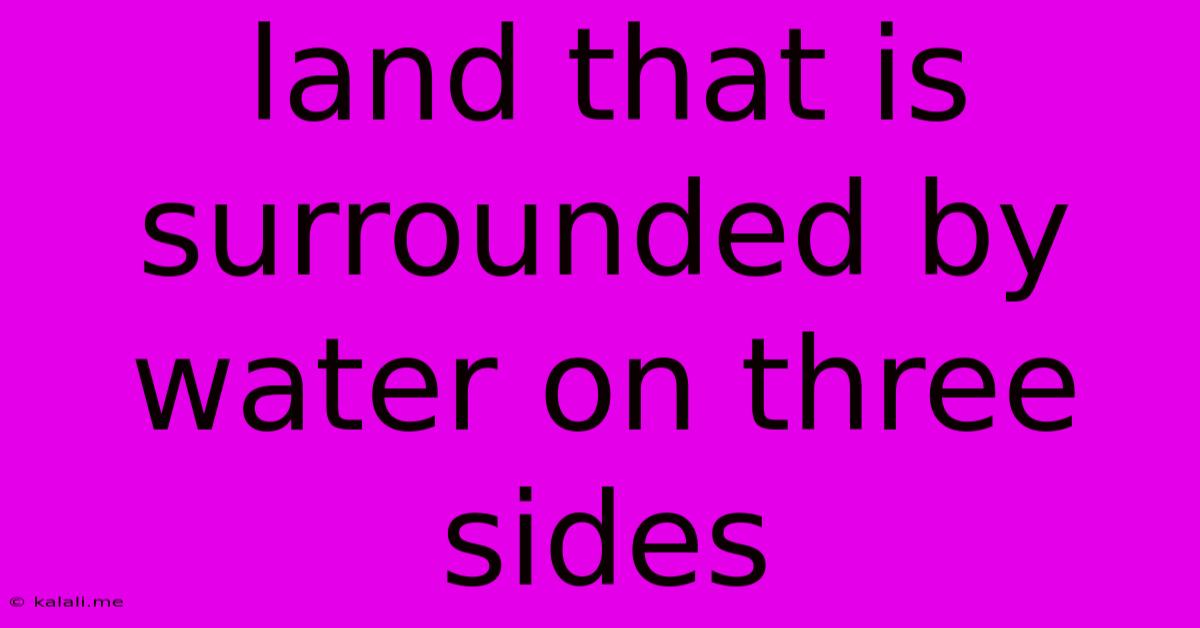Land That Is Surrounded By Water On Three Sides
Kalali
Jun 13, 2025 · 3 min read

Table of Contents
Land Surrounded by Water on Three Sides: Understanding Peninsulas, Headlands, and Capes
A landmass surrounded by water on three sides is a geographical feature that sparks curiosity. While the common term "island" might spring to mind, it's crucial to understand that this description encompasses several different landforms, each with unique characteristics and geological origins. This article will delve into the nuances of peninsulas, headlands, and capes, clarifying their distinctions and exploring their fascinating features.
What Defines a Peninsula, Headland, and Cape?
The key difference lies in size, shape, and the surrounding geography. While all three are landforms surrounded by water on three sides, their distinctions are based on their scale and connection to the mainland.
-
Peninsula: A large area of land projecting into a body of water and connected to a larger landmass by an isthmus – a narrow strip of land. Peninsulas are typically extensive and may house various geographical features, including mountains, rivers, and even smaller peninsulas within them. Think of the Iberian Peninsula (Spain and Portugal) or the Korean Peninsula; these are vast landmasses.
-
Headland: A smaller, often more rugged, piece of land projecting into the sea. Headlands are frequently characterized by steep cliffs and are formed by the erosional processes of waves and tides. They are generally smaller and less extensive than peninsulas. Coastal erosion often plays a significant role in shaping their distinctive forms.
-
Cape: Similar to a headland, a cape is a pointed piece of land extending into a body of water. The primary difference is largely one of naming convention; the term "cape" is often used more prominently in geographical naming, particularly in specific locations. Both capes and headlands can be associated with dramatic coastal scenery. For example, Cape Cod in Massachusetts or Cape Horn at the southern tip of South America.
Geological Formation and Significance
The formation of these landforms is often a result of a complex interplay of geological processes. These include:
- Tectonic activity: The movement and collision of tectonic plates can uplift landmasses, creating peninsulas.
- Erosion and deposition: Waves and currents erode softer rock, leaving behind resistant rock formations which stand as headlands or capes. Deposition of sediment can also create land extensions over time.
- Glacial activity: Glaciers carving valleys and leaving behind moraines can contribute to the formation of peninsulas and headlands. The unique landscape of many peninsulas in colder regions owes a considerable debt to glacial action.
Ecological Importance and Human Impact
These coastal landforms are often hotspots of biodiversity, supporting unique ecosystems. The varied topography and exposure to sea and land create diverse habitats for a wide range of flora and fauna.
However, these areas are also often susceptible to human impact. Coastal development, pollution, and climate change pose significant threats to the delicate balance of these ecosystems. Understanding the unique characteristics of peninsulas, headlands, and capes is essential for effective conservation efforts.
In Conclusion:
While the phrase "land surrounded by water on three sides" paints a broad picture, the reality is more nuanced. Peninsulas, headlands, and capes each represent distinct geographical features, differing in scale, formation, and ecological significance. Understanding these differences is crucial for appreciating the diversity of coastal landscapes and for implementing effective environmental management strategies. These landforms continue to captivate and inspire, offering stunning vistas and valuable insights into the power of natural processes.
Latest Posts
Latest Posts
-
Good Words To Describe Your Mom
Jun 14, 2025
-
Essentially The Output Of Aggregate Planning Is The
Jun 14, 2025
-
Which Of The Following Statements About Gender Is True
Jun 14, 2025
-
The Underlined Part Of The Sentence Is A
Jun 14, 2025
-
What Is A Factor Of 95
Jun 14, 2025
Related Post
Thank you for visiting our website which covers about Land That Is Surrounded By Water On Three Sides . We hope the information provided has been useful to you. Feel free to contact us if you have any questions or need further assistance. See you next time and don't miss to bookmark.